
Resurrection of a King
Part V: Reconstruction of the Old Racer
In the past few decades, there has been a lot of interest in having our automobile racing history revived. In Thunder Bay, Russ Wanzuk has one of the largest private collections of race cars and memorabilia in Canada. He has shown tremendous enthusiasm toward the restoration of the King's Special since he first became aware that parts of the original car still existed. His inspiration, together with Kevin Mowle's tireless efforts to find more information about the car, were almost enough on their own to inspire the author to do something with his unique collection of artifacts, but more persuasion came from others who seemed only remotely interested in automobiles.
In the late 1980's, after the overhead cam engine had been positively identified and traced to the King's Special, Kate and Diane at the Northwestern Ontario Sports Hall of Fame were particularly keen to find more about the legendary vehicle. By having displays, and publishing articles in the local newspapers, they were able to acquire much information that was previously unknown, and the best photograph of the car that has ever been found. Also, they procured the names and contact information of men who had first-hand knowledge of the old race car. Two of those fellows, Red (Louis) Marsonet and Ed Cusson had raced back in the twenties and thirties, and they were able to provide many details of the King's Special that were not identifiable from the old photographs. The wheel size and design, engine components, and even the shock absorbers were described by name and appearance. It was their testimony that tied the wire wheels that the Cronk brothers had picked up from a farm on the Pole Line road, not far from Murillo, to the King's Special.
One final bit of memorabilia had surfaced that convinced the author that it was time to put his artifacts on public display:
Kevin Mowle had found original 16mm film footage of race cars on the Lakehead Exhibition track, taken between 1932 and '34. There had been deterioration of the picture quality over the years, and the photographer was no doubt new to the technology, but there is no mistake that the King's Special is one of the cars featured on the movie. The car is seen fish-tailing around the dirt track, obviously going very fast. As it veers toward the inside of the track at one point, one can read the words, 'King's Special' on its hood. The same film shows Red Marsonet rolling his Model T bug (a stripped down Ford) completely over and back on his wheels in front of a large audience. (In that incident, he cracked one of the bones in his leg, but raced the next day with his injury).
As always, we win some; and, we lose some. After all the effort Kevin made to preserve this precious footage (it was the earliest known movie film of car racing in Canada), the film was loaned to an organization in the Lakehead and was never returned to its owner. The film may have disappeared forever. Fortunately, Kevin had had copies made at the University library on VHS tape, but much of the detail was lost in the transfer. The incident brought to mind that our memorabilia will not last forever, and in this case, didn't even survive long enough to be around when the car was finally resurrected. It was time for the King's Special to make a re-appearance.
The catalyst that brought it all together was a man who almost single-handedly founded the Canadian Motor Racing Historical Society. Jim Dunham, inspired a lot of people to take an interest in the historical aspects of our hobby. Among other events he organized to celebrate 100 years of racing in Canada, he arranged for an exhibit of race cars at Performance World in 2001. A few months before the show, he wrote the author, hoping that the King's Special would be restored by that date, and would be part of the Toronto show. The car was considered to be, at that time (and nothing to the contrary has surfaced since), the oldest Canadian-built racer in existence, that had a history of racing in Canada.
In about three months, the parts that had been collected over the years came together, with a lot of help from 'The Canadian T' man (Kevin). It is built on a Model T frame that had been purchased in 1961 from a farmer on the Oliver Road, east of Murillo (This T frame, at one point, had been sold out of the family to Russ Wanzuk, but through his enthusiasm to see the race car rebuilt, kindly allowed it to revert back to the Cronks in 1988). The superstructure of a body was fabricated, relying on pictures and early 'speed' documents to portray the 1930 version of the car as closely as possible. Essentially only the chassis with a skeleton of a cockpit was trailered to Toronto in time for the show.


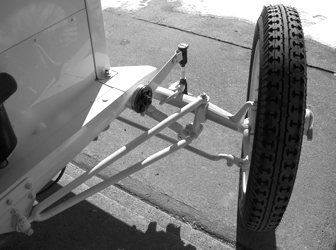
Performance World was a show that attracted a huge following generally, and this was no exception. Although the partially built racer was a very minor exhibit compared to most of the displays, it garnered more interest than this writer had ever imagined. From teenagers to old men and women, there were many who were surprised and impressed with the technology that was used in the construction of the racer, so many years ago. Also, the video that was set up showing the car, performing in its heyday, made a big impression on those who came by. More than one curious spectator, though, wondered when the car was going to be finished, considering many of it's parts had been in the hands of the present owner for almost forty years. Well, there had been a few set-backs.
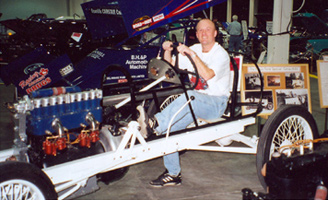
First of all, there was the problem establishing what was needed to bring it back to the way it was in 1930. Then, actually finding those parts for sale took decades. The internet wasn't an option for us in those days. One particularly important lead came from a fellow in Ohio who had a double-overhead cam Roof engine of about the same age as ours. That, in turn, led us to an old man in Detroit who had spent his entire life building race cars for the Indy 500. It was he who provided the side drive, Scintilla magneto, water pump, oil pump, and water manifold that belonged to our engine. Another racer in the Niagara region gave up the twin Winfield carburetors that he no longer had a use for. Then, in Washington State, a head gasket was purchased that was one of several that had been specially made for the Model T racing heads. But the biggest stumbling block had to do with the wheels.
The 72-spoke racing wire wheels that were on the chassis at the car show matched the description given by both Red Marsonet and Ed Cusson, (and later, when the car was on display at the Lakehead Airport, by Bill Kelso). They were racing-style wire wheels with clincher rims that took a 30 x 3 ½" tire (23" rim size). However, a close examination of the early pictures of the car showed that a different style hubcap was used in the 1925-30 period that the car was raced, and the wheels seemed to have a smaller rim diameter. A Model T Race enthusiast in California was finally able to shed light on our dilemma. He identified the early wheels shown in the photographs of the King's Special as early Daytons. They were drop-center rims, rather than clinchers, and took a 20" tire, rather than a 23". The hub cap badges sported four rivets originally, and were later held on by only two. A close examination of one of our early photographs shows the four rivets on the left front wheel. A probable explanation why the three old race veterans were wrong about the size of the wheels is that the wheels were switched sometime between 1933 and the late 40's. It was highly probable that, during the Great Depression, the early racing tires from Ohio were either not available, or were very expensive. The later skinnier tires were common to regular Model T's and would have been easy to come by, so using the larger diameter wire wheels (which Kevin eventually traced to a Windsor manufacturer) would have made a lot of sense for the owner of the race car at that time.
The difficulty for us, who were determined to rebuild the King's Special to the way it was in 1930, entailed finding the type of wheels that were on the car at that time. This became an international search. Early Daytons are very rare today, and are highly in demand by those restoring early 1920's Indy racers. It took years to find four of these wheels, and only one hub ever showed up. Tom and Denny Newman, from Michigan, located three wheels at one of the largest automotive flea markets in the world: Hershey (Pennsylvania), but the wheels weren't available at one time. On average, Denny said, one would show up about every four years! A forth wheel came from California. New hubs were eventually cast from ductile iron, using the one original as a pattern. Days of machining went into the shaping of these hubs. Likewise, the hubcaps were also custom made, using an original as a pattern. Fortunately, one of Kevin's contacts in Arizona was restoring similar Daytons, and was able to supply the required brass badges that are riveted to the centers of the knock-off hubcaps.

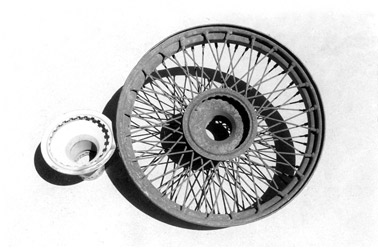
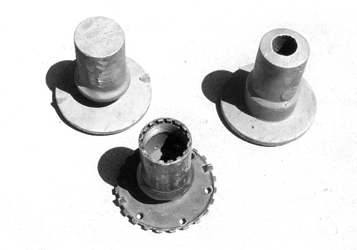
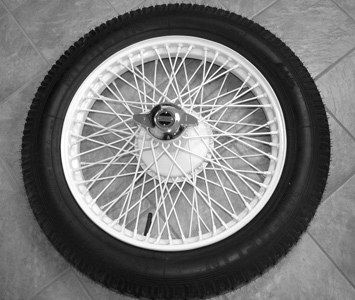
In the process of tracing the lineage of the wire wheels, a number of other facts were revealed that filled in some of the gaps in the story of the King's Special during the thirties and forties. According to Red Marsonet (audio tape made with Red, in the presence of Russ Wanzuk, Jerry, Al, and Sandra Cronk in May of 2001), formal races ceased in 1934 due to the effects of the Depression. Two years later, so the tape states, the King family traded in the old race car on a new 1936 Pontiac. Red himself helped push the racer into the Kam Motors display window area where it was put up for sale. Shortly after, a "stupid jerk" (Red's words) bought the racer for $30, and then proceeded to drive it around the East End without a licence. The garage wouldn't sell it to Red because they figured he would have killed himself in it.
The car may have swapped owners several times in the next few years. The next entry in our documentary is around 1944-45 at which time a Joe Zanutto and Nick Dokuchic (information from NWO Sports Hall of Fame, 1988) swapped a 1929 Essex for it. In a telephone conversation with the latter in 1988, the author heard how the owner took off the two Winfield carburetors because they would sometimes ice up at the Labour Day races and freeze wide open. He replaced them with a more conventional make. Other than that, the only problem he had with the car was with one connecting rod that he had to replace, being careful to drill, shave, and balance it to match the other three. He was pleased with the performance of the car. Obviously racing continued during the forties, but it was most likely unofficial.
Shortly after the war, the car ended up at May Auto Parts where a friend of Red Marsonet, Slim Daglish, bought it and gave it to him (according to an interview with Red, 2001). Red claimed that the engine was complete and in good condition when he had it, but for some reason (that he didn't explain), he dismantled the car, keeping the motor and racing accessories, selling the wheels to someone in Murillo, and letting the body go to someone in Rosslyn Village. Later, he was sure that he knew who ended up with the wheels, someone also in Rosslyn (interview with the author in the early 90's). Although he didn't mention it, the body may have had extensive collision damage when he decided to take it apart. Pictures of the car taken during the late forties would shed more light on this topic.
A tragic turn of events occurred on Thanksgiving Day, 1963 (Red's interview, 2001). Red's brother was killed in a hunting accident. It was in his brother's garage that Red had temporarily stored the parts of the King's Special. When he went to retrieve the goods, days after the funeral, to put them into a chicken coup on his own property (isn't this where the story began?), the garage had been cleaned out. He was absolutely disgusted and bitter to learn, almost thirty years later, that the engine and other parts had left the Lakehead altogether, and were in some guy's basement in Southern Ontario. But there was a silver lining to this saga. Once he learned that the race car was being rebuilt with the parts that he had lost, he went out of his way to help, in any way he could, to bring the project to completion. Sadly, he passed away before he could see the finished product.
There is a bit of controversy about just when the King's Special met its final demise. Those following the history of racing in the Lakehead would have heard that Barry Kettering's first race car was the King's Special, and that he raced it against Tommy Dow. Red denied knowing anything about that; after all, at that time, 1949, he himself had the racing engine and other speed parts in his own garage. (He also claimed to have had the 16 valve head from the Dreadnought). He had dismantled the car a year or so before that, according to him. Tom Dow offered an explanation for the conflicting details: he stated in a letter to the author,
"I raced informally on the Murillo track around 1949, but Barry's car bore little resemblance to the King's Special of the 1930's. The engine was a stock Model T flathead, the hood was gone, and the car had a regular T radiator."
He couldn't remember details about the wheels.
Whatever parts of the King's Special Barry found, he located them at the Twin City Crossroads, according to one article. The location is consistent with where the Cronk brothers picked up the front and rear axles of the King's Special in 1958, the summer this writer turned 16, and got his driver's licence. Both axles eventually required extensive rebuilding, and the front was significantly twisted, probably due to collision damage. Two men recently related incidents about the King's Special that happened in 1946 or '47. Bill Montgomery witnessed, from the cab of a tow truck, the push-starting of the race car down Oliver Road. Once it started, he exclaimed, it took off with such acceleration that he couldn't believe what he was seeing. It was the only time he ever saw the car, until it appeared at the Airport in 2010. Reg Vaillant had experienced something quite different years ago. Around 1946, he and a Joe Allen had possession of the King's Special and while they were driving at high speed on a gravel road, the driver lost control and tore the rear-end out when the car struck a hydro pole.
Whether it was this incident, or some other, we can be pretty sure that everything - - body, engine, and chassis, were pretty-well beat up by the time the car was taken apart and sold for parts. It's fortunate that everything didn't end up in the scrap yards.
Over its lifetime, the King's race car went through at least three body make-overs, and probably hundreds of alterations to its running gear. It was originally grey, with a big #4 on the front of it. By 1930, the same basic chassis sported a narrow, white body, with no number, but with 'King's Special' on either side of its hood. About 18 years later, it was still in existence, even raced, but the lack of photographic evidence of it at that time makes one wonder if it was such an eyesore no one thought to take a picture of it.
Rebuilding a race car, such as the King's Special, is not the same as restoring a factory-made auto. The home-built machine has no blueprints, no shop manuals, and generally no one documenting what is being used at any time during its racing career. The rebuilder/restorer must rely on whatever evidence surfaces over time. Fortunately, for the many people who were involved in the resurrection of the King's Special, there has been a wealth of information that has come from the public over the past 30 years, making the re-birth of this famous auto possible.
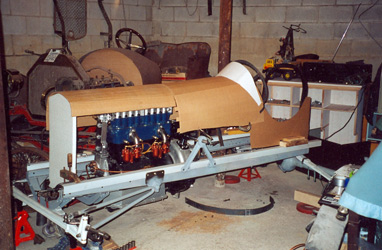
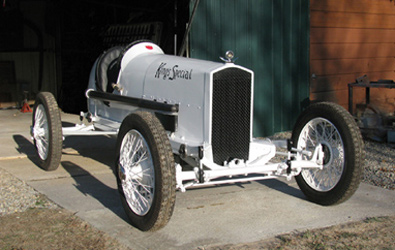
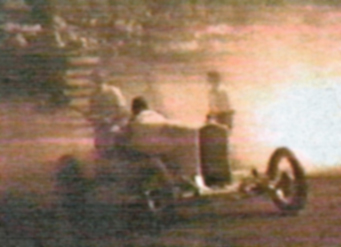
The present version of the King's Special consists of parts original to the car in 1930, including the motor, transmission, steering box, front and rear axle assemblies, together with 'period-correct' accessories that were available at that time. The body, and 'impossible-to-find' items, have been meticulously re-manufactured to original specifications, where possible, using early photographs, blue-prints, and patterns of original parts as references.
Besides the many people already mentioned in this essay, there are many others who have contributed to recording the history of the King's Special, and preserving the artifacts that have come to light, as well as helping directly with the re-construction of the car. In no particular order, the following have been significant supporters:
* Bill Colosimo, who was enthusiastic from the beginning, provided may photographs, and filled us in with anecdotes about his famous father's driving antics;
* Lois Garrity, and the Museum staff, who arranged to have the car on display at the Duke Hunt Historical Museum in the summer of 2010, and later, with the co-operation of the Management of the Thunder Bay Airport, exhibition space and regular maintenance at the airport;
* Bill Kelso, who had an excellent memory for details of the car dating back to the 1930's, and provided stories and information that lead to more exact detailing of car, particularly as it had to do with the dash board design;
* Chris Rantala, artist, who was able to capture the essence of racing in the early thirties in a fabulous painting, prints of which are proudly displayed in many homes and at the Duke Hunt Museum;
* Howie McEachern, for saving the original film footage of racing in the early 1930's;
* Dave Cano and Jeff Caldwell, as well as my daughters, Rachelle and Sheryl, who have used press and internet coverage to offer the public information about the early racing in the Thunder Bay area.
* Rachelle has also created some unique photos of the King's Special, and helped immensely with the electronic imaging of parts of the car that had to be custom built;
* James Roof, grandson of the King's Special engine's designer, Robert M. Roof. James provided copies of original literature on the car's Victory 8 conversion;
* Helen and Alan Cronk of Vancouver, who provided funding toward the car's reconstruction;
* And of course, the King family, without whom, we would have no car, and indeed, no story!
Now, in 2014, exactly 100 years after the first automobile race in Fort William/Port Arthur, it seems fitting that the King's Special be returned to the Lakehead, and be a permanent exhibit at the Duke Hunt Historical Museum. The 91-year history of this car is unique in Canada; as far as we know, there is no other Canadian built race car in this country that comes close to matching the documented history of this one.
Performance World 2001, Custom Car & Truck Show, Toronto
Plunkett's Fleetwood Country Cruize-in, London, 2010. Donations to several charities have averaged over $90,000 per year since 2002.
Invade the Close, Sarnia, 2012, which raised over $3000 for the Salvation Army.
EyesOn Design, 2013, at the Edsel Ford Estate, Grosse Pointe Shores, Michigan, which has donated an average of $150,000 per year since 1987, for the visually impaired.
The Inaugural 2013 Cobble Beach Concours D'Elegance, Georgian Bay, which raised over $50,000 for the construction of a helipad on the Sunnybrook Hospital in Toronto.
2014 Michigan Jamboree of T's, Lapeer, hosted by the Casual Model T's of Michigan.